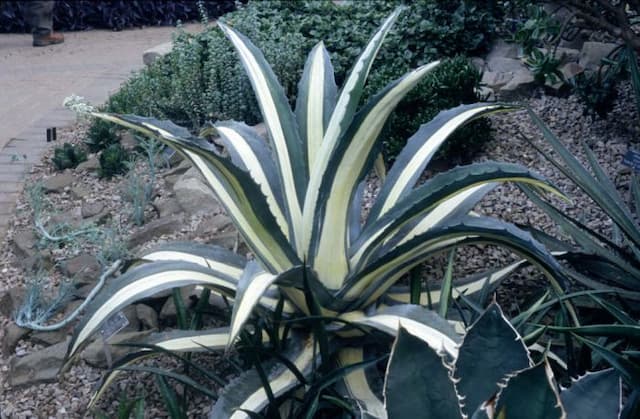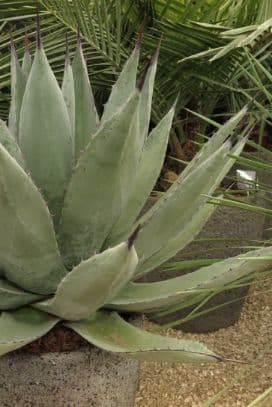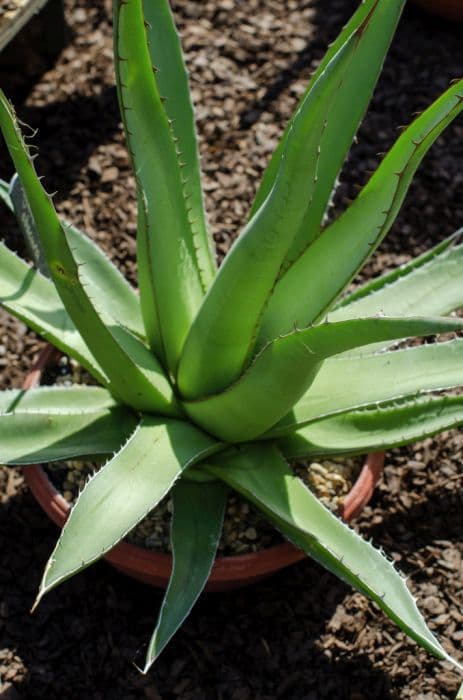Plantain Lily Hosta 'North Hills' (fortunei) (v)

ABOUT
Hosta 'North Hills' is a perennial plant with a lush, mound-forming habit that boasts broad, heart-shaped leaves. These leaves are known for their attractive appearance, with deep green coloration that sometimes has a glossy texture. The foliage often displays distinct variegation, featuring lighter, possibly creamy or yellowish edges that contrast beautifully with the deeper green center. Additionally, this variety of Hosta is appreciated for its flowers. It produces tall stalks above the foliage which bear bell-shaped flowers. The flowers are often a soft lavender or pale purple color, adding a delicate touch of color to the plant's already pleasing aesthetic. These blooms are not only visually appealing but can also attract pollinators like bees and hummingbirds to the garden. Overall, Hosta 'North Hills' is characterized by its dense clumps of eye-catching foliage and decorative floral display, creating an appealing addition to any shade garden or mixed border. Its leaves provide a robust and textured ground cover that remains attractive throughout the growing season, while the flowering stems add vertical interest and a splash of color during their bloom time.
About this plant
 Names
NamesFamily
Asparagaceae
Synonyms
Plantain Lily, Funkia, Hosta
Common names
Hosta fortunei 'North Hills'.
 Toxicity
ToxicityTo humans
The Hosta, commonly referred to as Plantain Lily, is not considered toxic to humans. In fact, some parts of the plant are edible when properly prepared. However, as with any plant not typically consumed, individuals may have personal or allergic reactions, and it is generally not advisable to ingest plants that are not intended for consumption without proper knowledge and preparation.
To pets
Hosta plants, or Plantain Lilies, are known to be toxic to pets, particularly dogs and cats. If ingested, the plant can cause vomiting, diarrhea, and may lead to depression in pets. It is advisable to prevent your pets from having access to the leaves and flowers of this plant to preclude potential poisoning. If you suspect your pet has ingested Hosta, you should contact your veterinarian immediately.
 Characteristics
CharacteristicsLife cycle
Perennials
Foliage type
Deciduous
Color of leaves
Green
Flower color
Lavender
Height
2 feet (60 cm)
Spread
3 feet (91 cm)
Plant type
Herb
Hardiness zones
3
Native area
Asia
Benefits
 General Benefits
General Benefits- Aesthetic Appeal: Hosta 'North Hills' has attractive foliage that serves as an eye-catching addition to shade gardens.
- Low Maintenance: This variety of hosta is relatively easy to care for, requiring minimal upkeep beyond occasional watering and annual fertilization.
- Shade Tolerance: It thrives in shaded areas where other plants may struggle, making it ideal for woodland gardens or dark corners of the yard.
- Versatility: Hostas are versatile and can be used in a variety of landscape designs, including borders, container gardens, and ground covers.
- Seasonal Interest: Despite being primarily known for their foliage, hostas also produce delicate flowers that can add an extra element of interest to the garden, typically in mid to late summer.
- Drought Resistance: Once established, Hosta 'North Hills' can be quite drought tolerant, reducing the need for frequent watering in suitable climates.
- Wildlife Attraction: The flowers of the hosta can sometimes attract pollinators like bees, and the dense foliage can provide shelter for small animals.
 Medical Properties
Medical PropertiesThis plant is not used for medical purposes.
 Air-purifying Qualities
Air-purifying QualitiesThis plant is not specifically known for air purifying qualities.
 Other Uses
Other Uses- As a natural dye: The leaves of the Hosta 'North Hills' can be used to create green dyes for textiles, providing an environmentally friendly option for coloring fabrics.
- Hosta leaf casting: The large leaves of the Hosta can be used in a decorative art form called leaf casting, creating detailed concrete sculptures for garden ornaments.
- Biodegradable plates and platters: The broad leaves of the Hosta 'North Hills' can serve as biodegradable serving dishes for outdoor gatherings, reducing the need for disposable plastic or paper goods.
- Privacy screen: When planted in mass, Hosta 'North Hills' can form a dense ground cover, providing a low-height privacy screen in gardens or along walkways.
- Culinary garnishing: Although not widely known for their taste, Hosta leaves can be used as a decorative, non-toxic garnish on food dishes for an unusual presentation.
- Photography backdrop: The lush foliage of the Hosta 'North Hills' can be a beautiful, natural backdrop for macro or plant photography, adding texture and a vibrant green to images.
- Educational tool: Hostas, including the 'North Hills' variety, can be used in educational settings to teach about plant growth habits, shade tolerance, and gardening for biodiversity.
- Leaf pressing and botanical art: The textured leaves of Hostas are suitable for leaf pressing, making them a great choice for creating botanical art and crafts.
- Fish pond enhancement: Hosta 'North Hills' can be planted around garden ponds to provide shade and shelter for fish, as well as to enhance the naturalistic look of the water feature.
- Thematic gardening: Hosta 'North Hills' can be used in Japanese-themed gardens or other garden styles that emphasize foliage and simplicity, complementing other shade-loving plants.
Interesting Facts
 Feng Shui
Feng ShuiHostas are not specifically mentioned in traditional Feng Shui practice; however, in general, lush green plants like hostas can be used to add a sense of growth and vitality to a space and to soften sharp corners, thereby promoting a flow of positive energy.
 Zodiac Sign Compitability
Zodiac Sign CompitabilityHostas are not used in astrology practice.
 Plant Symbolism
Plant Symbolism- Resilience: Hosta plants are known for their ability to thrive in shade and adapt to various soil conditions, symbolizing the strength and resilience to thrive under challenging circumstances.
- Longevity: With their ability to live for decades, hostas can represent enduring life, longevity, and the capability to withstand the test of time.
- Self-care: Requiring minimal sunlight, the hosta suggests the importance of self-care and finding strength in introspection and rejuvenation.
- Devotion: As perennials that return each year, hostas symbolize devotion and loyalty, reflecting the plant's dependable nature.
- Peace and Solitude: Often found in serene garden settings, hosta plants can evoke a sense of peace and solitude, offering a tranquil retreat from the outside world.
 Water
WaterHostas, including 'North Hills', should be watered deeply to encourage root development, which typically means providing about one inch of water per week. Adjust the frequency based on weather conditions; during hot or dry spells, they may require more frequent watering, while cooler, rainy periods will lessen the need. A good approach is to water them once or twice a week, depending on the soil moisture level. Early morning watering is ideal as it allows the foliage to dry before nightfall, reducing the risk of fungal diseases. Always check the top couple of inches of soil for dryness before watering again to prevent overwatering.
 Light
LightFor optimal growth, plant 'North Hills' Hosta in a location that receives partial to full shade. Direct afternoon sun can cause leaf burn, so a spot that gets filtered light or morning sun with afternoon shade is ideal. Hostas thrive under the canopy of trees, or on the north side of buildings where they can be protected from the harsh midday sun.
 Temperature
TemperatureHostas prefer moderate temperatures and are hardy in USDA zones 3 through 8, which corresponds to a range of roughly -40 to 80 degrees Fahrenheit. The 'North Hills' Hosta can tolerate winter lows down to -40 degrees Fahrenheit and summer highs up to about 80 degrees Fahrenheit, but they grow best when summer temperatures average around 70 to 75 degrees Fahrenheit. Sudden temperature fluctuations, particularly heat waves, can stress the plant.
 Pruning
PruningPrune your 'North Hills' Hosta to remove dead or damaged leaves throughout the growing season to maintain plant health and aesthetics. Additionally, cut back the foliage to ground level after the first hard frost in fall to help control pests and diseases. Pruning is not required for growth, but it helps keep the garden tidy and can prevent slug and snail infestations, which prefer the shelter of the thick leaves.
 Cleaning
CleaningAs needed
 Soil
SoilHostas, commonly known as Plantain Lilies, thrive in soil that is rich, well-draining, and has a pH range of 6.0 to 7.5. A good soil mix can include one part garden soil, one part compost, and one part perlite or pine bark fines to ensure adequate drainage and fertility.
 Repotting
RepottingPlantain Lilies should be repotted every few years or when they outgrow their current container. The best time to repot is in the spring before they begin active growth. Hostas growing in the ground typically do not need repotting.
 Humidity & Misting
Humidity & MistingPlantain Lilies prefer moderate humidity levels but are quite adaptable to various humidity conditions found in typical garden settings. They do not require the high humidity that some more tropical plants might.
 Suitable locations
Suitable locationsIndoor
Plantain Lilies need bright, indirect light and room to spread.
Outdoor
Provide shade, moist soil and space for growth.
Hardiness zone
Plantain Lilies are suitable for USDA zones 3-9.
 Life cycle
Life cycleHosta 'North Hills' emerges in the spring when soil temperatures rise, starting as tightly rolled shoots known as "pips" that unfurl into large, broad leaves. Throughout the spring and early summer, the leaves expand and form a dense, leafy clump. In mid to late summer, it sends up tall flower stalks that bear lavender or white blooms, attracting bees and other pollinators. After flowering, seed pods may develop, but many gardeners remove the flower stalks to encourage foliage growth. As temperatures drop in the fall, Hosta 'North Hills' enters dormancy; its foliage dies back and the plant conserves energy in its root system. With the return of warmer weather the following spring, the cycle begins anew with the emergence of new growth from the overwintered rhizomes.
 Propogation
PropogationPropogation time
Spring-Early Summer
Propogation: Hosta 'North Hills', commonly known as Hosta or Plantain Lily, can be propagated most effectively through division, which is best done in the early spring or fall. To propagate via division, you first dig up the plant, being careful to keep as much of the root system intact as possible. The clump should then be gently separated into smaller sections, each with at least two or three shoots and a portion of the root system attached. These divisions can be replanted immediately into a prepared garden area, spacing them at least a foot (about 30 centimeters) apart to provide enough room for growth. Water the newly planted divisions thoroughly to help establish them in their new locations. This method not only propagates new plants but also rejuvenates older clumps by giving them more space to grow. Division is beneficial for the health of the Hosta 'North Hills' as it helps to prevent overcrowding and promotes vigorous growth.









